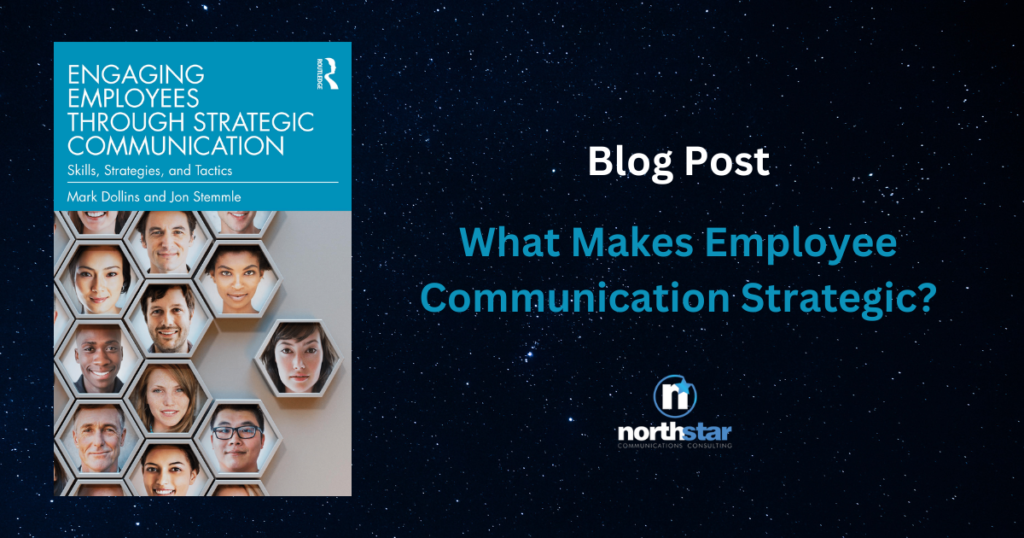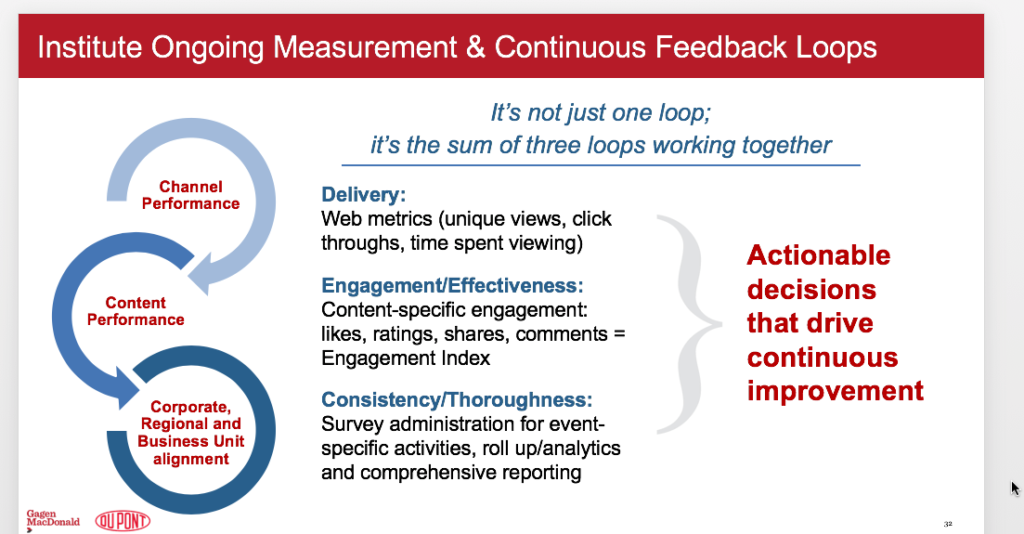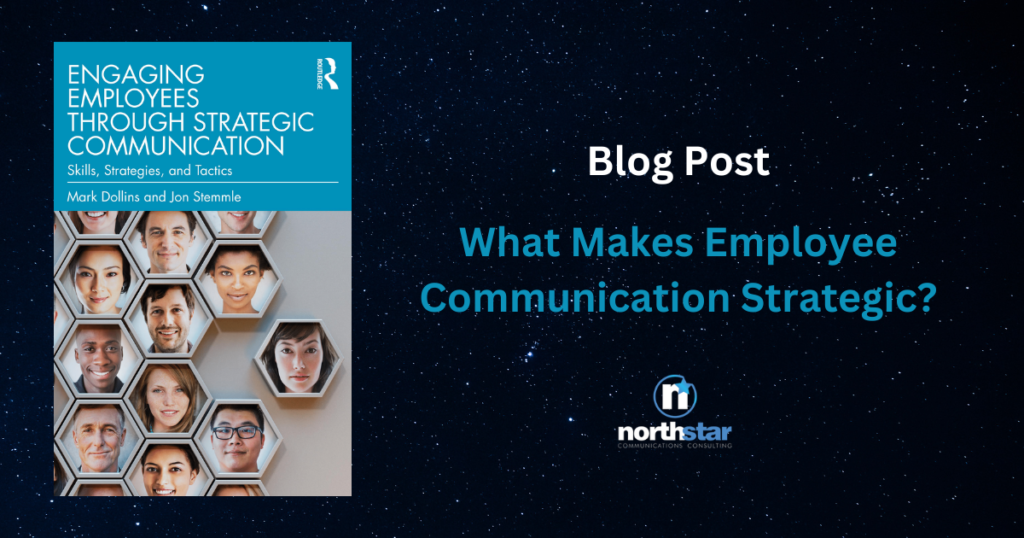
This blog post briefly summarizes chapter two of the book Engaging Employees Through Strategic Communication by Mark Dollins and Jon Stemmle. Visit engage-employees.com to grab your copy today.
What makes employee communications strategic? It sounds like a basic question to those of us who have been doing it a while. But it goes far beyond the days of broadcasting information to workers. Fundamentally, it’s communicating with employees to achieve a predetermined outcome. It’s about moving past the idea of informing internal stakeholders, to influencing how they think about a particular topic, and — ultimately — how they behave.
Like advertising and marketing, it’s communicating with a purpose that goes beyond a simple need to know. Unlike those communication disciplines — which tend to focus primarily on either building an affinity for a brand or intent to purchase a product of service — employee communications can, and does, go deeper into business issues and opportunities.
According to Richard Perloff, managers spend about 80% of their time communicating with others, typically dealing with persuading others to do, or accomplish, specific tasks or goals. Whether it’s changing employee behavior on a manufacturing floor to reduce or eliminate accidents, or driving a belief in a vision of a business and driving recruiting and retention numbers, employee communications is uniquely positioned — and expected – to influence how employees think and act on behalf of the enterprise that employs them.
As discussed in the article “Employee communication for engaging workplaces” in the Journal of Business Strategy, to complete the influence of strategic employee communications, we need to find ways of delivering employee belief that our topic or cause is worth believing in, and that it requires a new or different action on the part of our workforce. Achieving these objectives through employee communications more often demands a higher-touch experience — delivered in compelling, creative ways from leaders and other influencers in smaller groups, or with face-to-face, live interactions.
Finding strategic employee communications solutions to business problems is a lot like chemistry. The best answers come from choices we make on everything from what we put into the solution to the timing, cadence and sequencing selections we make. In this case, our chemicals are messaging, channels, target audiences and timing to push and pull levers that deliver the results we seek.
The answers we deliver as strategic communicators can be as unique as the organizations we serve, but when it comes to the use of digital versus verbal communications, the delivery of communications from human to human has a distinct advantage in at least one way. To drive belief and behavior change, it takes more personal kinds of communication delivery to affect a change with employees. That’s because it affords opportunity for direct, instantaneous feedback and – if done well – prompts dialogue that helps employees trust management and truly engage in both the strategy and tasks they’re being asked to deliver.
Having great tools and compelling content is a good start for employee communications, but using those resources strategically demands unique, relevant insights from internal stakeholders, clarity on success measures, creative ideas and clear messaging that sticks. All of those elements must be woven together to deliver clear and compelling results. And as internal communications strategies are created and executed, the importance of using flexibility and creativity invariably drive the ability to execute a strategy, and still deliver intended results.
A key challenge is that employees are smarter than they’ve ever been about how businesses operate, and care a lot more about context than ever. They want to know how management expects them to work harder, and why they need to work faster. How do they sell more when there are disruptive technologies, products and services that may be better than what their employers offer?
The answers to those kinds of questions — combined with the need to understand how employees best process information, what they care about, what change is required, and what factors are influencing an enterprise and its market(s) — begin to illustrate why employee communications must be increasingly strategic.
Organizational communicators must have insights about their employee base, develop effective methods of connecting with them, measure the impact of their communication efforts and report progress to executive management. In other words, they must move from outputs to outcomes.
Employee communicators historically have taken refuge in reporting on the volume of activity they’ve achieved. When thinking about outputs, it’s more often along the lines of reporting how many articles have been written, how many emails were opened, when, and/or who they reached. Those all add up to outputs — actions that may show how busy they’ve been, but have less to do with producing an outcome that the enterprise cares about.
To be clear, executive management cares about outcomes. And they’re increasingly holding employee communications accountable for delivering them with the resources they’ve been allocated. That’s not altogether a bad thing. Employee communicators who produce solid, continuous outcomes more often get additional resources with which to work, versus those who don’t.
The building blocks of strategic internal communications include a clear set of objectives, supported with strategies and tactics that deliver on those objectives. The building blocks of the strategy and their related tactics include feedback loops, internal stakeholder segmentation (often referenced as “personas”), audience insights, content and creative development, channel effectiveness, measurement/analytics and reporting.

This feedback summary from the DuPont company illustrates how employee communicators used a series of feedback loops to measure and assess effectiveness during its merger of equals with the Dow company in 2017 and 2018.
Feedback loop results and corresponding actions with employees delivers a clear and compelling message that “the organization” is not only digesting employee feedback, but is taking action to improve what needs improvement, eliminate what isn’t working or bolstering what does work.
Are you interested in the other building blocks of the strategy and their related tactics, including internal stakeholder segmentation (often referenced as “personas”), audience insights, content and creative development, channel effectiveness, measurement/analytics and reporting? Grab a copy of Engaging Employees Through Strategic Communication today at engage-employees.com.
Get Your Copy Of The Engaging Employees Through Strategic Communication Book Or Contact North Star Communications Today

The diagram above shows the different topics covered in the book. Take advantage of the opportunity to enhance your organizational communication strategy and engage your employees effectively by getting your hands on the highly recommended book, Engaging Employees Through Strategic Communication by Mark Dollins and Jon Stemmle. Piqued your curiosity? Want to know why change communications, Block Chain, Artificial Intelligence and employee activism will shape our near-term future? Visit engage-employees.com to grab your copy today.
If you’re looking for expert guidance in implementing change communications, talent development, and coaching in your organization, look no further than North Star Communications Consulting. Contact us today to schedule a free consultation and take the first step toward transforming your organizational communication approach.


